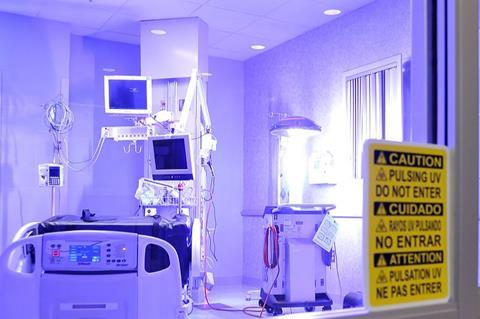Experts are working on a new type of ultraviolet light called far-UVC that could be highly effective for reducing air-borne transmission of diseases such as COVID-19 and influenza, as well as surface contamination in hospitals, with hopes that it could even reduce the risk of the next pandemic.

In a new research review presented at this year’s ESCMID Global Congress (formerly ECCMID) in Barcelona, Spain (27-30 April), Dr Curtis Donskey from the Louis Stokes Cleveland VA Medical Center in Cleveland, Ohio, USA, will discuss the efforts being made to develop this continuous surface and air decontamination technology in clinical settings and the safety concerns that still need to be addressed.
In the face of a persistent global pandemic, disinfectants are more important than ever. Airborne transmission of diseases such as COVID-19 and tuberculosis in public spaces has highlighted a clear need for improved technologies to limit their spread. Similarly, environmental contamination plays a key role in the spread of healthcare-associated infections, with pathogens such as Methicillin-resistant Staphylococcus aureus (MRSA) and Clostridioides difficile able to persist on surfaces, contributing to the spread of infections. More than 3.5 million healthcare-associated infections occur in the European Union and European Economic Area (EU/EEA) every year, leading to over 90,000 deaths.
Continuous decontamination
“Compounding the problem, and a major limitation of traditional cleaning and disinfection strategies, is that disinfected surfaces rapidly become re-contaminated between manual cleaning episodes,” explains Dr Donskey. “Daily cleaning of patient rooms is likely to be inadequate to reduce the burden of infectious pathogens, and manual cleaning of intricate surfaces, equipment, and devices makes thorough cleaning difficult. These limitations have led to the development of technologies that can provide continuous decontamination of occupied spaces between episodes of manual cleaning. The holy grail is a technology that is effective against surface and airborne pathogens and is automated, safe, and reasonably priced.”
One of the most promising candidates are ultraviolet light technologies. “It’s been known since the 1940s that ultraviolet light can kill bacteria and inactivate viruses in the air so that they are no longer infectious,” says Dr Donskey. “Conventional UV light has been used widely in hospitals and prisons, but it can damage the skin and eyes, so it can only be used when a room is empty. Because re-contamination of rooms and surfaces is so quick, the goal has been to continuously decontaminate rooms with people in them.”
Shorter wavelength
Far UV-C has a shorter wavelength (222 nm) than conventional germicidal UVC light (254 nm) and cannot penetrate or harm skin, eyes or tissue. Studies have shown that far-UVC light can kill the SARS-CoV-2 virus, other human coronaviruses, influenza, and drug-resistant bacteria quickly and efficiently. And because of the way ultraviolet light kills microbes, viruses, and bacteria, they cannot develop resistance as they do with vaccines and drug treatments. Additional tests in real-room environments have found that far UV-C reduced infectious airborne viruses by over 99%—much greater than is generally achieved using typical air filtration and ventilation.
“Several studies have suggested that far UV-C light at the current regulatory limit may be safe for use around people, but more studies are needed to confirm the safety of these rays in clinical settings and with longer-term follow-up before it is likely that they will be routinely used in occupied healthcare settings,” cautions Dr Donskey. “It is also vital that we assess ozone concentrations because far UV-C technologies have the potential to generate modest amounts of ozone.” Based on the information currently available, the US Centers for Disease Control and Prevention has stated that in the near-term whole-room UV is best viewed as new and emerging technology.
Commercial technology
Nevertheless, far UV-C (222 nm) has emerged as a leading continuous decontamination technology with several commercial technologies currently being marketed. A few of the companies marketing far UV-C devices include Ushio (Care222 Filtered Far UV-C Excimer Lamp Module), Sterilray (GermBuster Channel), Lit Thinking (Visium), and Far UV Technologies.
“Some early adopters have begun using these technologies in healthcare settings,” says Dr Donskey. “For example, a dental office in Ohio installed far UV-C lamps in 5 patient treatment rooms in 2020 and has operated the technology for thousands of hours with no reports of adverse effects. Partnering with such early adopters could be useful to acquire information on long-term safety of far UV-C.”
He adds, “One novel approach that could accelerate earlier implementation of far UV-C in clinical settings would be its intermittent rather than continuous delivery. Such an approach would only deliver far UV-C when a room is empty and turns off when people are present. We are currently evaluating this intermittent approach for decontamination of equipment rooms, bathrooms, sinks, and patient rooms. We anticipate that hospitals will be more willing to consider use of the technology in clinical areas using this approach while additional safety data is being generated.”







No comments yet